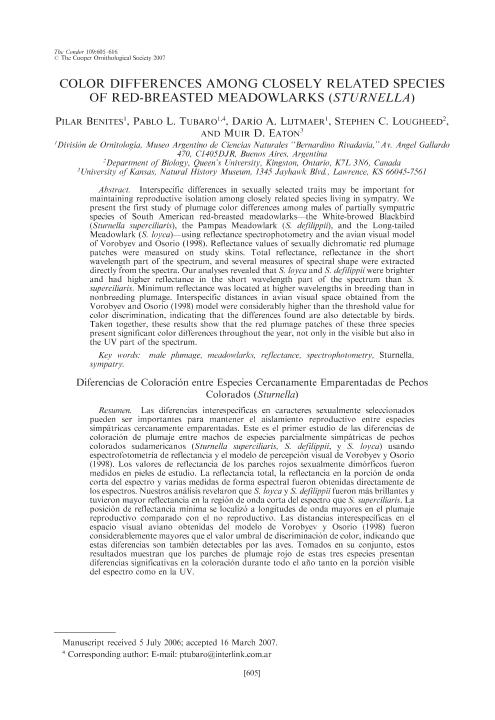Artículo
Interspecific differences in sexually selected traits may be important for maintaining reproductive isolation among closely related species living in sympatry. We present the first study of plumage color differences among males of partially sympatric species of South American red-breasted meadowlarks (the Long-tailed Meadowlark, the Pampas Meadowlark and the White-browed Blackbird, Sturnella loyca, S. defilippii and S. superciliaris, respectively) using reflectance spectrophotometry and the avian visual model of Vorobyev and Osorio (1998). Reflectance values of sexually dichromatic red plumage patches were measured on study skins. Total reflectance, reflectance in the short wavelength part of the spectrum and several measures of spectral shape were extracted directly from the spectra data. These variables were subjected to two-way ANCOVAs, with species and season (breeding/non-breeding) as main factors and year of capture as a covariate. These analysis revealed that S. loyca and S. defilippii were brighter and had a higher reflectance in the short wavelength part of the spectrum than S. superciliaris. The wavelength of minimum reflectance showed higher values in breeding plumage versus non-breeding. Interspecific distances in avian visual space were considerably higher than the threshold value for color discrimination, denoting that the differences found are also detectable by birds. Taken together, these results showed that the red plumage patches of these three species present significant color differences throughout the year not only in the visible but also in the UV part of the spectrum. Las diferencias interespecíficas en caracteres sexualmente seleccionados pueden ser importantes para mantener el aislamiento reproductivo entre especies simpátricas cercanamente emparentadas. Este es el primer estudio de las diferencias de coloración de plumaje entre machos de especies parcialmente simpátricas de pechos colorados sudamericanos (Sturnella superciliaris, S. defilippii,yS. loyca) usando espectrofotometría de reflectancia y el modelo de percepción visual de Vorobyev y Osorio (1998). Los valores de reflectancia de los parches rojos sexualmente dimórficos fueron medidos en pieles de estudio. La reflectancia total, la reflectancia en la porción de onda corta del espectro y varias medidas de forma espectral fueron obtenidas directamente de los espectros. Nuestros análisis revelaron que S. loyca y S. defilippii fueron más brillantes y tuvieron mayor reflectancia en la regio´n de onda corta del espectro que S. superciliaris. La posición de reflectancia mínima se localizó a longitudes de onda mayores en el plumaje reproductivo comparado con el no reproductivo. Las distancias interespecíficas en el espacio visual aviano obtenidas del modelo de Vorobyev y Osorio (1998) fueron considerablemente mayores que el valor umbral de discriminación de color, indicando que estas diferencias son también detectables por las aves. Tomados en su conjunto, estos resultados muestran que los parches de plumaje rojo de estas tres especies presentan diferencias significativas en la coloración durante todo el año tanto en la porción visible del espectro como en la UV
Color differences among closely related species of Red-Breasted Medowlarks (Sturnella)
Título:
Diferencias de Coloracio´n entre Especies Cercanamente Emparentadas de Pechos Colorados (Sturnella)
Benites, Maria del Pilar ; Tubaro, Pablo Luis
; Tubaro, Pablo Luis ; Lijtmaer, Dario Alejandro
; Lijtmaer, Dario Alejandro ; Lougheed, Stephen C.; Eaton, Muir D.
; Lougheed, Stephen C.; Eaton, Muir D.
 ; Tubaro, Pablo Luis
; Tubaro, Pablo Luis ; Lijtmaer, Dario Alejandro
; Lijtmaer, Dario Alejandro ; Lougheed, Stephen C.; Eaton, Muir D.
; Lougheed, Stephen C.; Eaton, Muir D.
Fecha de publicación:
01/08/2007
Editorial:
Cooper Ornithological Society
Revista:
The Condor
ISSN:
0010-5422
Idioma:
Inglés
Tipo de recurso:
Artículo publicado
Clasificación temática:
Resumen
Palabras clave:
MALE PLUMAGE
,
MEADOWLARKS
,
REFLECTANCE
,
SPECTROPHOTOMETRY
Archivos asociados
Licencia
Identificadores
Colecciones
Articulos(MACNBR)
Articulos de MUSEO ARG.DE CS.NAT "BERNARDINO RIVADAVIA"
Articulos de MUSEO ARG.DE CS.NAT "BERNARDINO RIVADAVIA"
Citación
Benites, Maria del Pilar; Tubaro, Pablo Luis; Lijtmaer, Dario Alejandro; Lougheed, Stephen C.; Eaton, Muir D.; Color differences among closely related species of Red-Breasted Medowlarks (Sturnella); Cooper Ornithological Society; The Condor; 109; 3; 1-8-2007; 605-616
Compartir
Altmétricas



